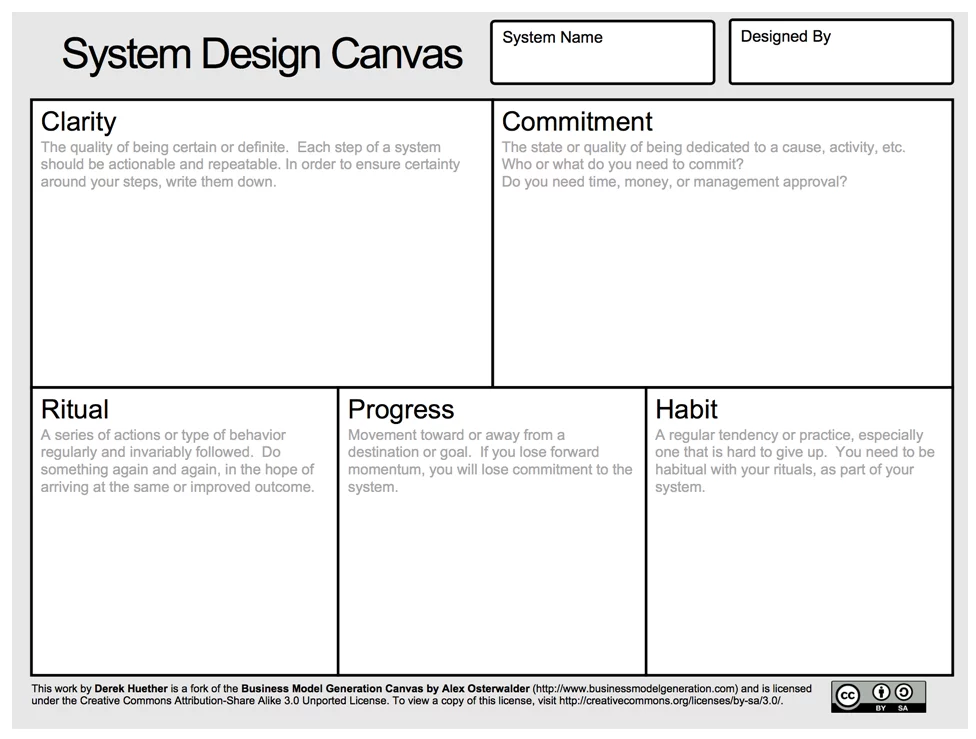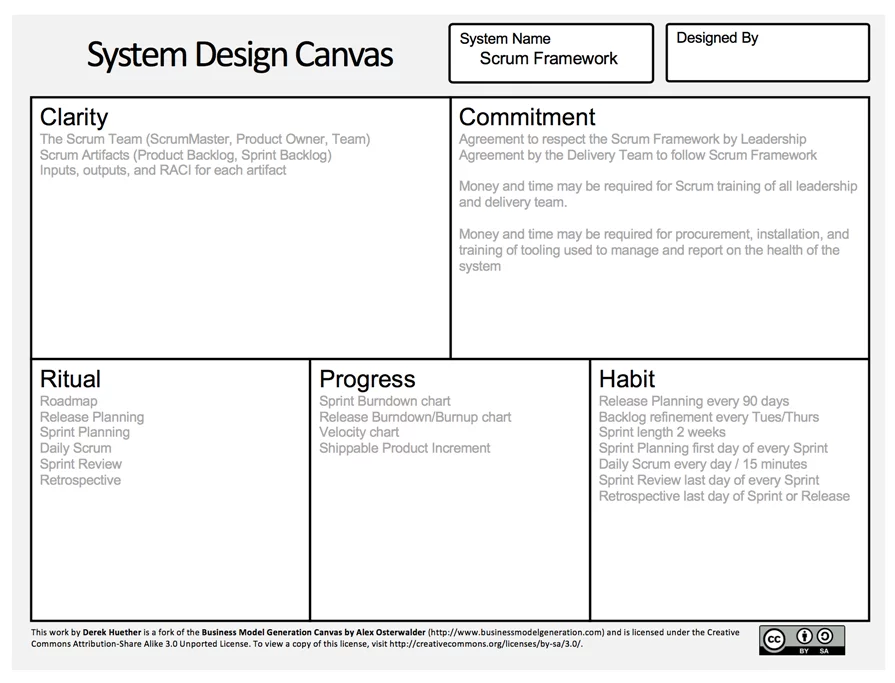System Design Canvas
In a previous post about productivity patterns, I wrote about how I tried countless systems to improve my productivity. I tried everything from having a Franklin Planner, to using GTD, to Personal Kanban and the Pomodoro Technique. I asked myself why some methods worked and some did not. Why did I abandon two systems when I knew so many others have been successful with them? Why has Personal Kanban worked for me for the last 7 years? I started listing common traits and saw relationships and discovered patterns. Not only are there three things I believe every system needs to work, I also see three things that are necessary to prevent you from abandoning that system.
Every personal or professional thing we do is part of a system or subsystem. Those systems have both success and failure patterns.
Success Patterns
For a system (defined as a set of principles or procedures to get something done or accomplished) to be successful, you always need ritual and habit.
- A ritual is a series of actions or type of behavior regularly and invariably followed by someone.
- A habit is a regular tendency or practice, especially one that is hard to give up. You need to be habitual with your rituals, as part of your system.
Failure Patterns
Early indicators that your system will fail include a lack of clarity, progress, or commitment
(Very similar to Mike Cottmeyer’s “Why Agile Fails)
- Lack of clarity creates confusion and waste. Each step of a system should be actionable and repeatable. In order to ensure certainty around your system steps, write them down.
- If you lack progress, you will lose momentum. If you lose momentum, you will lose commitment to the system.
- Lack of commitment to the system results in you no longer using the system. You move on to something new to get the results you seek.
System Design Canvas
After I identified the patterns, I wanted to present a useful model to visualize the indicators that will, in time, cause the system to fail. I decided to base my model on the Business Model Canvas by Alex Osterwalder. Below you will see the five areas that need to be considered. Once complete, if you notice one or more of the sections is ambiguous or short on details, you should view that as a warning.

Scrum Framework Success Patterns
By using the Scrum Framework as an example system, I completed my system design canvas. Upon completion of the worksheet below, I can see if there are any “gaps” in the system. As you may have guessed, there are no gaps, if Scrum is properly implemented and followed. But if it was modified without expert guidance, a gap will become visible and provide an indication that the system is at risk of failure.

Because you may have a large organization where you are dealing with different kinds of dependencies, you may need to create “sub” system design canvases to account for organizational complexity. Scrum may not be enough. Don’t worry. The same rules apply.
Free Download
Interested in testing your system or subsystems? Download a free copy of the System Design Canvas and see if you are at risk of failure. Because I am providing this under a Creative Commons Attribution-Share Alike 3.0 Unported license, I welcome you to download it and modify it to meet your needs.

Comments (4)
Barry Hodge
Thank you for this I am going to download it and give it a go. I have personally found that clarity and habit are both very important. I think combining them on this is a great idea.
Barry, I really appreciate that feedback and I hope you find the canvas useful. Let me know how it turns out! ~Derek
Greg Krauska
So is habit merely the frequency of the ritual? How in practice does it add value to separate the two?
Greg, excellent questions. Listing habit separately from ritual is to force you to think through it separately. Do you do the ritual frequently enough? Are you committed to the habit, not just the ritual? If not, is there a gap and a risk of failure. It’s a thinking exercise. You may have commitment to do the ritual one time but do you have commitment and clarity around doing it again and again?
As an example, I commit to the ritual to run. I need a different kind of commitment and feedback loop to maintain the ritual and to maintain my “personal health” system. I hope you found my explanation helpful.